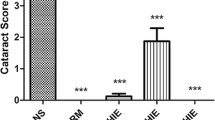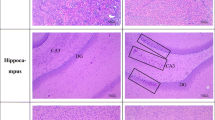Abstract
Recently, much interest has been generated in the search for phytochemical therapeutics, as they are largely free from adverse side effects and economical. The goal of this study was to determine the efficacy of Vitex negundo in modulating the selenite-induced oxidative stress in vivo model. Sprague–Dawley rat pups of 8 days old were used for the study and divided into control (G I), selenite induced (G II), and selenite + V. negundo treated (G III). Cataract was induced by the single subcutaneous injection of sodium selenite (4 mg/kg body weight) on the tenth day and V. negundo (2.5 mg/Kg body weight) administered intraperitoneally from eighth to 15th day. Morphological examination of the rat lenses revealed no opacification in G I and mild opacification in G III whereas dense opacification in G II (stages 4–6). Levels of selenium in G II and G III showed no significant changes. The activities of superoxide dismutase, catalase, and Ca2+ATPase were significantly increased in G III compared to G II (p < 0.05), while lower level of reactive oxygen species, Ca2+, and thiobarbituric acid reactive substances were observed in G III compared G II (p < 0.05). These results indicate the therapeutic potential of methanolic extract of V. negundo on modulating biochemical parameters against selenite-induced cataract, which have been reported in this paper for the first time.








Similar content being viewed by others
Abbreviations
- SOD:
-
Superoxide dismutase
- ROS:
-
Reactive oxygen species
- TBARS:
-
Thiobarbituric acid reactive substances
References
Nirmalan PK, Krishnadas R, Ramakrishnan RD, Thulasiraj R, Katz J, Tielsch JM, Robin AL (2003) Lens opacities in a rural population of southern India: the aravind comprehensive eye study. Invest Ophthalmol Vis Sci 44:4639–4643
Spector A (1995) Oxidative stress induced cataract: mechanism of action. FASEB J 9:1173–1182
Gupta PD, Johar K, Vasavada A (2004) Causative and preventive action of calcium in cataractogenesis. Acta Pharmacol Sin 25:1250–1256
Doganay S, Turkoz Y, Evereklioglu C, Er H, Bozaran M, Ozerol E (2002) Use of caffeic acid phenethyl ester to prevent sodium selenite-induced cataract in rat eyes. J Cataract Refract Surg 28:1457–1462
Ostadalova I, Babicky A, Obenberger J (1978) Cataract induced by administration of a single dose of sodium selenite to suckling rats. Experientia 34:222–223
Shearer TR, Ma H, Fukiage K, Azuma M (1997) Selenite nuclear cataract: review of the model. Mol Vis 38:1–14
Gupta SK, Trivedi D, Srivastava S, Joshi S, Halder N, Verma SD (2003) Lycopene attenuates oxidative stress induced experimental cataract development: an in vitro and in vivo study. Nutrition 19:794–799
Gupta SK, Srivastava S, Trivedi D, Joshi S, Halder N (2005) Ocimum sanctum modulates selenite-induced cataractogenic changes and prevents rat lens opacification. Curr Eye Res 30:583–591
Sakthivel M, Elanchezhian R, Ramesh E, Isai M, Nelson Jesudasan C, Thomas PA, Geraldine P (2008) Prevention of selenite-induced cataractogenesis in Wistar rats by the polyphenol, ellagic acid. Exp Eye Res 86:251–259
Lija Y, Biju PG, Reeni A, Cibin TR, Sahasranamam V, Abraham A (2006) Modulation of selenite cataract by the flavonoid fraction of Emilia sonchifolia in experimental animal models. Phytoher Res 20:1091–1095
Biju PG, Rooban BN, Lija Y, Gayathri Devi V, Sahasranamam V, Annie A (2007) Drevogenin D prevents selenite-induced oxidative stress and calpain activation in cultured rat lens. Mol Vis 13:1121–1129
Dharmasiri MG, Jayakody AC Jr, Galhena G, Liyanage SSP, Ratnasooriya WD (2003) Anti-inflammatory and analgesic activities of mature fresh leaves of Vitex negundo. J Ethnopharmacol 87:199–206
Hiraoka T, Clark JI (1995) Inhibition of lens opacification during the early stages of cataract formation. Invest Ophthalmol Vis Sci 36:2550–2555
Kakkar P, Das B, Viswanathan PN (1984) A modified spectrophotometric assay of superoxide dismutase. Ind J Biochem Biophys 21:130–132
Aebi H (1984) Catalase in vitro. In: Packer L (ed) Methods in Enzymology. Academic, New York, Vol. 105, pp 121–126
Rorive G, Kleinzeller A (1974) Ca2+-activated ATPase from renal tubular cells. In: Packer L (ed) Methods In Enzymology. Academic, New York, vol 32, pp 303–306
Davidson JF, Whyte B, Bissinger PH, Schiestl RH (1996) Oxidative stress is involved in heat induced cell death in Saccharomyces cerevisiae. Proc Natl Acad Sci USA 93(10):5116–5121
Niehaus WG Jr, Samuelsson B (1968) Formation of malonaldehyde from phospholipid arachidonate during microsomal lipid peroxidation. Eur J Biochem 6:126–130
Lowry OH, Rosebrough NJ, Farr AL, Randall RJ (1951) Protein measurement with the Folin phenol reagent. J Biol Chem 193:265–275
Steel RGD, Torrie JH, Dickey DA (1996) Principles and procedures of statistics. McGraw Hill, New York
Ohia SE, Opere CA, LeDay AM (2005) Pharmacological consequences of oxidative stress in ocular tissues. Mut Res 579:22–36
Varma SD, Chand D, Sharma YR, Kuck JF Jr, Richards RD (1984) Oxidative stress on lens and cataract formation: role of light and oxygen. Curr Eye Res 3:35–57
Ganea E, Harding JJ (2006) Glutathione-related enzymes and the eye. Curr Eye Res 31:1–11
Geraldine P, Brijit Sneha B, Elanchezhian R, Ramesh E, Kalavathy CM, Kaliamurthy J, Thomas PA (2006) Prevention of selenite induced cataractogenesis by acetyl-L-carnitine: an experimental study. Exp Eye Res 83:1340–1349
Liu L, Paterson CA, Borchman D (2002) Regulation of Sarco/Endoplasmic Ca2+-ATPase expression by calcium in human lens cells. Exp Eye Res 5:583–590
Ahuja RP, Borchman D, Dean WL, Paterson CA, Zeng J, Zhang Z, Yankey FS, Yappert MC (1999) Effect of oxidation on Ca2+-ATPase activity and membrane lipids in lens epithelial microsomes. Free Radic Biol Med 27:177–185
Elanchezhian R, Sakthivel M, Geraldine P, Thomas PA (2009) The effect of acetyl-L-carnitine on lenticular calpain activity in prevention of selenite-induced cataractogenesis. Exp Eye Res 88:938–944
Varma SD, Hegde KR (2004) Effect of alpha-ketoglutarate against selenite cataract formation. Exp Eye Res 79:913–918
Esterbauer H, Schaur RJ, Zollner H (1991) Chemistry and biochemistry of 4 hydroxynonenal, malonaldehyde and related aldehydes. Free Radic Biol Med 11:81–128
Awasthi S, Srivastava SK, Piper JT, Singhal SS, Chaubey M, Awasthi YC (1996) Curcumin protects against 4-hydroxy-2-noneal induced cataract. Am J Cli Nutr 64:761–766
Elanchezhian R, Ramesh E, Sakthivel M, Isai M, Geraldine P, Rajamohan M, Nelson Jesudasan C, Thomas PA (2007) Acetyl-L-carnitine prevents selenite-induced cataractogenesis in an experimental animal model. Curr Eye Res 32:961–971
Acknowledgments
We gratefully acknowledge the financial assistance from Kerala State Council for Science Technology and Environment (KSCSTE), Government of Kerala, India, as a research grant (Order No. (T) 17/R&D augmentation/04/KSCSTE, dated 20-2-2004) to Dr. Annie Abraham. Authentication of the plant material by Mrs. Gayathri Devi. V, Scientist, Regional Research Institute, Poojapura, Trivandrum, Kerala, India is duly acknowledged. Junior research fellowship to Ms. Sasikala V from CSIR, New Delhi, India is gratefully acknowledged.
Author information
Authors and Affiliations
Corresponding author
Rights and permissions
About this article
Cite this article
Rooban, B.N., Sasikala, V., Sahasranamam, V. et al. Vitex negundo Modulates Selenite-Induced Opacification and Cataractogensis in Rat Pups. Biol Trace Elem Res 138, 282–292 (2010). https://doi.org/10.1007/s12011-010-8633-1
Received:
Accepted:
Published:
Issue Date:
DOI: https://doi.org/10.1007/s12011-010-8633-1




